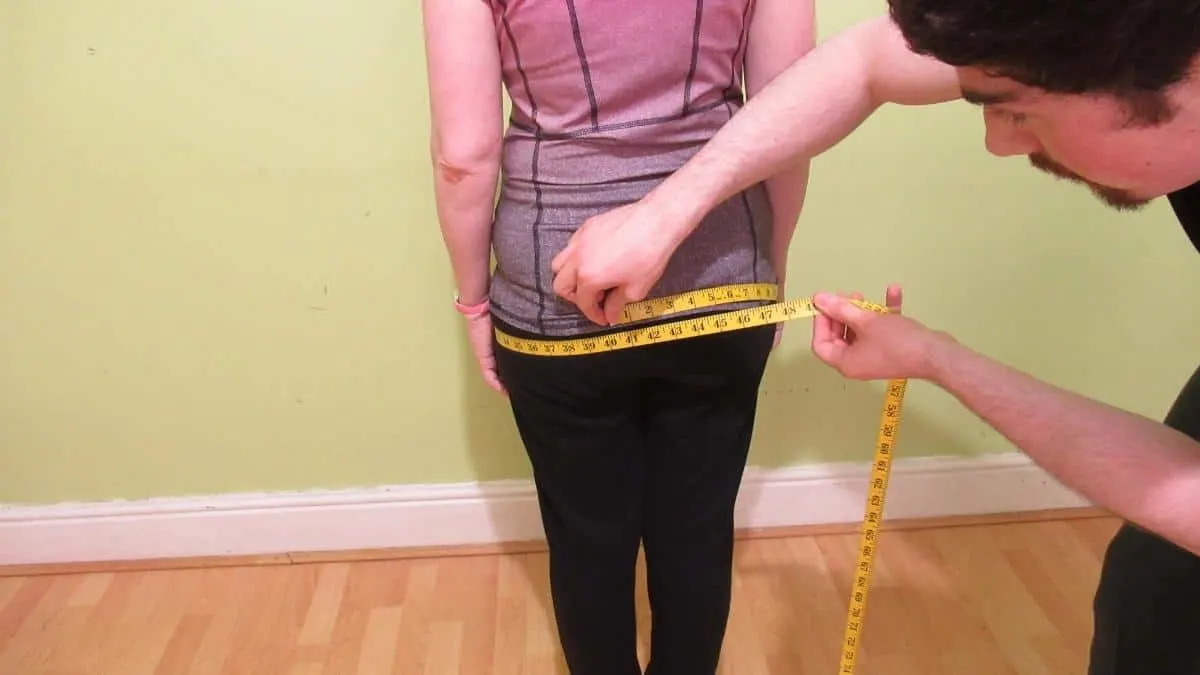Your hip measurement can be used to determine your physical health, fitness progress, and even your physical attractiveness.
With this in mind, knowing the average hip size for women, men, teenagers, and children can help you to understand how your body is built and what this means for your health and wellbeing.
So, in addition to showing you how to measure your hips and answering various frequently asked questions, we’ll also discuss the average hip measurements for both males and females of various ages.
Related Measurement Guides:
- Average butt size
- Average height for women
- Average female BMI
- Average women’s waist size
- Average wrist size for women
- Average human shoulder width
- Average arm circumference for females
- Average forearm measurement
- Average female thigh circumference
- Average calf circumference for females
- Average female neck circumference
- Average male chest measurements
What is the average hip size for women?
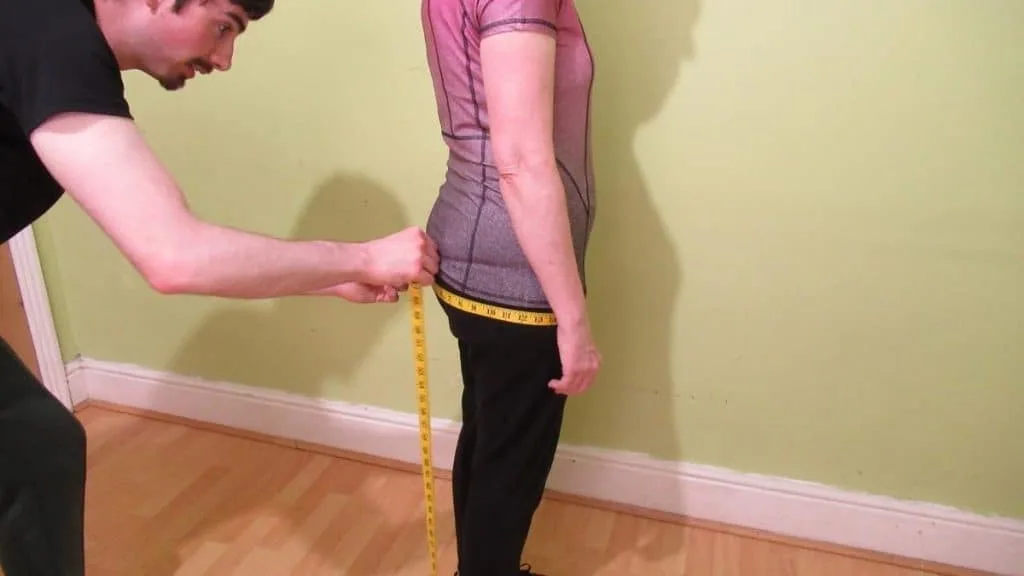
What is the average hip size for a woman? According to anthropometric reference data taken from the National Health and Nutrition Examination Survey, which measured the hips of 8,068 females, the average hip size for women is 40.2 inches or 102.2 cm. [1]
As expected, however, the average female hip size depends on the age of the woman being measured. But the general trend is that female hip circumference peaks during middle age and then gradually decreases as the woman gets older.
Specifically, women aged 20-29 had an average hip circumference of 38.7 inches or 98.2 cm, which was the lowest measurement of all the examined age groups.
Women aged 30-39 had an average hips size of 40.4 inches or 102.7 cm, whereas women aged 40-49 had an average hip measurement of 40.9 inches or 104 cm.
The largest female hip measurement was observed in the 50-59 age group, where the average hip girth was 41.5 inches or 105.4 cm.
Females aged 60-69 had 40.5 inch (103.1 cm) hips on average, whereas women aged 70-79 had 39.9 inch (101.4 cm) hips. Finally, women aged 80+ had an average hip measurement of 39.1 cm or 99.4 cm.
See How Your Hips Compare:
- 30 inch hips
- 31 inch hips
- 32 inch hips
- 33 inch hips
- 34 inch hips
- 35 inch hips
- 36 inch hips
- 37 inch hips
- 38 inch hips
- 39 inch hips
- 40 inch hips
- 41 inch hips
- 42 inch hips
- 43 inch hips
- 44 inch hips
- 45 inch hips
- 46 inch hips
- 47 inch hips
- 48 inch hips
- 49 inch hips
- 50 inch hips
- 60 inch hips
What is the average hip size for men?

What is the average male hip size? Based on data from a National Center for Health Statistics report that measured 7,411 adult males, the average hip size for men is 39.2 inches or 99.6 cm.
As with the female hip measurements, the male hip measurements also differ by age group. However, there is much less variation in male hip circumference, and the lowest measurements were observed in the very youngest and oldest participants.
Men aged 20-29 had an average hip circumference of 38.3 inches or 97.4 cm, whereas men aged 30-39 had 39.2 inch (99.6 cm) hips on average.
The average male hip circumference for men aged 40-49 and 60-69 was 39.6 inches or 100.6 cm, whereas men aged 50-59 had slightly larger 39.8 inch (101.1 cm) hips.
Finally, the average male hip measurement for men aged 70-79 and 80+ was 39.2 inches (99.6 cm) and 38.4 inches (97.5 cm), respectively.
What is the average hip circumference for teenage girls?
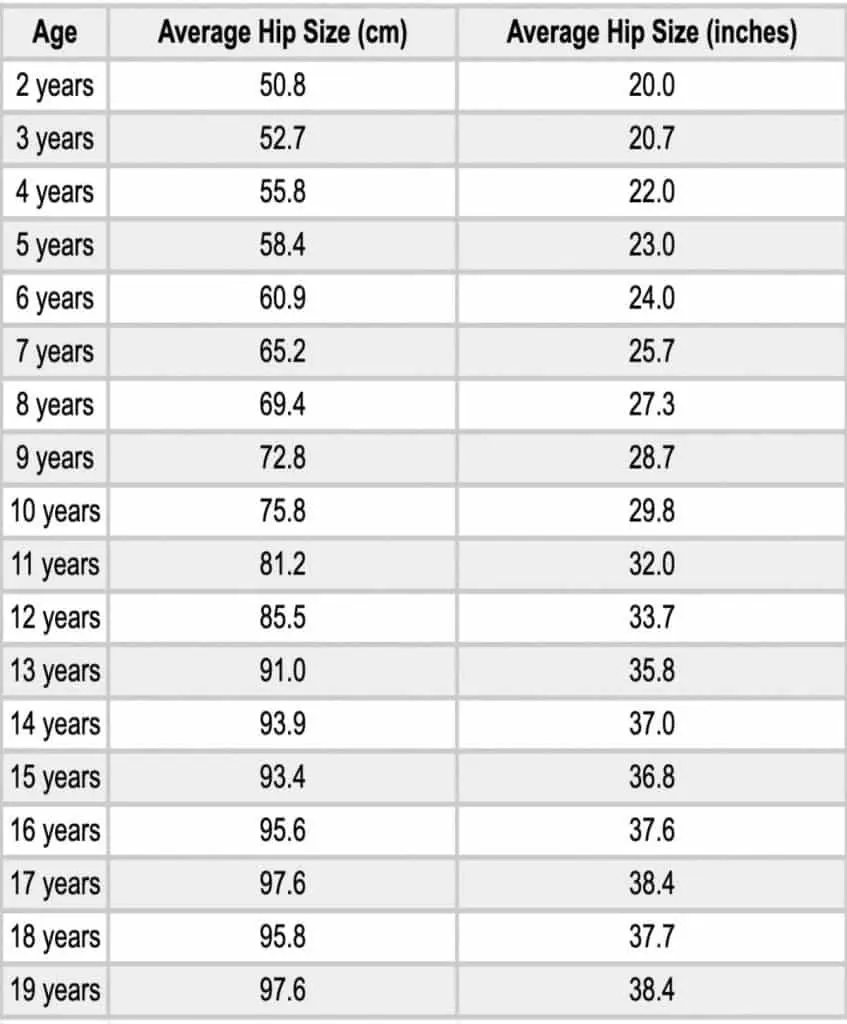
What is the average hip size for a teenage girl? According to US anthropometric data from the CDC, the average hip circumference for a teenage girl ranges from 35.8 inches at 13 years old to 38.4 inches at 19 years old.
As expected, the average hip measurement for a female teenager tends to increase as she gets older. Here is the measurement data by age.
The average hip measurement for a 13-year-old girl is 35.8 inches or 91 cm.
The average hip circumference for a 14-year-old girl is 37 inches or 93.9 cm.
For 15-year-old-girls, the average female hip size is 36.8 inches or 93.4 cm.
For 16-year-old girls, the average hip size is 37.6 inches or 95.6 cm.
The normal hip measurement for a 17-year-old girl was found to be 38.4 inches or 97.6 cm.
The normal hip size for an 18-year-old girl was found to be 37.7 inches or 95.8 cm.
Finally, the average female hip circumference for 19-year-old girls is 38.4 inches or 97.6 cm.
What is the average hip circumference for teenage boys?
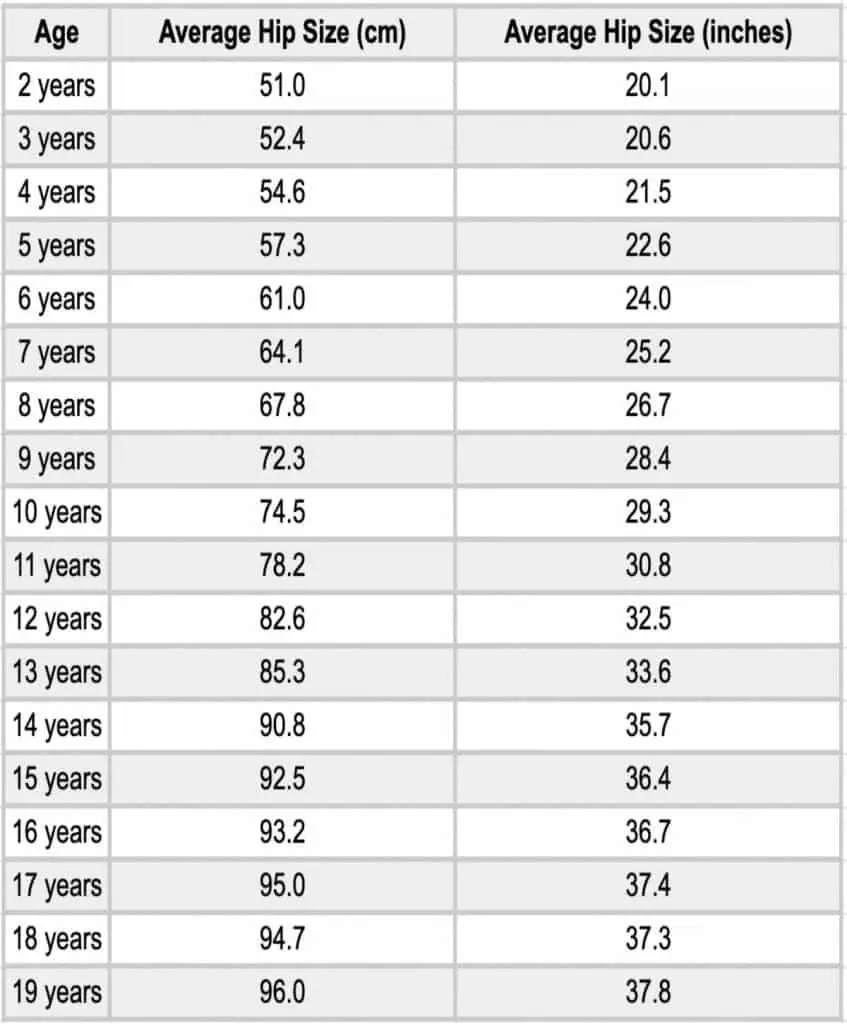
According to American anthropometric data, the average hip circumference for a teenage boy ranges from 33.6 inches at 13 years old to 37.8 inches at 19 years old.
Here is the breakdown by age:
As noted, 13-year-old boys had an average hip measurement of 33.6 inches or 85.3 cm.
14-year-old boys were found to have an average hip size of 35.7 inches or 90.8 cm.
For 15-year-old boys, the normal male hip size was found to be 36.4 inches or 92.5 cm.
The normal hip size for male 16-year-olds was found to be 36.7 inches or 93.2 cm.
For 17-year-old boys, the normal hip circumference was found to be 37.4 inches or 95 cm.
Finally, 18-year-olds had hips that measured 37.3 inches or 94.7 cm on average, whereas male 19-year-olds had 37.8 inch (96 cm) hips.
What is the average hip width for women?

What is the average female hip width measurement? According to US anthropometric research that measured the biiliac breadth of 8,356 females, the average hip width for women is 11.45 inches or 29.1 cm.
Biiliac breadth—which is essentially the anthropometric term for maximal hip width—is a measurement that’s taken between the most lateral points on the outer part of the iliac crest. [2]
What follows is the average female width for women of various ages.
Women aged 20-29 had a hip width of 10.9 inches, whereas women aged 30-39 had a hip width of 11.3 inches.
The average hip width for women aged 40-49 was 11.6 inches.
Females aged 50-59 and 60-69 both had an average hip width measurement of 11.9 inches.
Finally, women aged 70-79 and 80+ both had a hip width of 11.8 inches.
What is the average male hip width?

What is the average male hip width? Based on measurement data from a National Health and Nutrition Examination Survey, the average hip width for men is 11.7 inches or 29.6 cm.
Here is the average hip size by age group:
The average male hip width measurement was 11.2 inches for men aged 20-29, 11.5 inches for men aged 30-39, and 11.8 inches for men aged 40-49.
Men aged 50-59 and males aged 80+ both had an average hip width of 12 inches.
Finally, the normal hip width for men aged 60-69 and 70-79 was found to be slightly larger—although virtually identical—at 12.1 inches.
Hip size charts
The following 5 hip size charts discuss hip width and hip circumference for males and females. Additionally, the first chart shows you what female clothing sizes each hip measurement is equal to.
Female hip size chart (clothing)
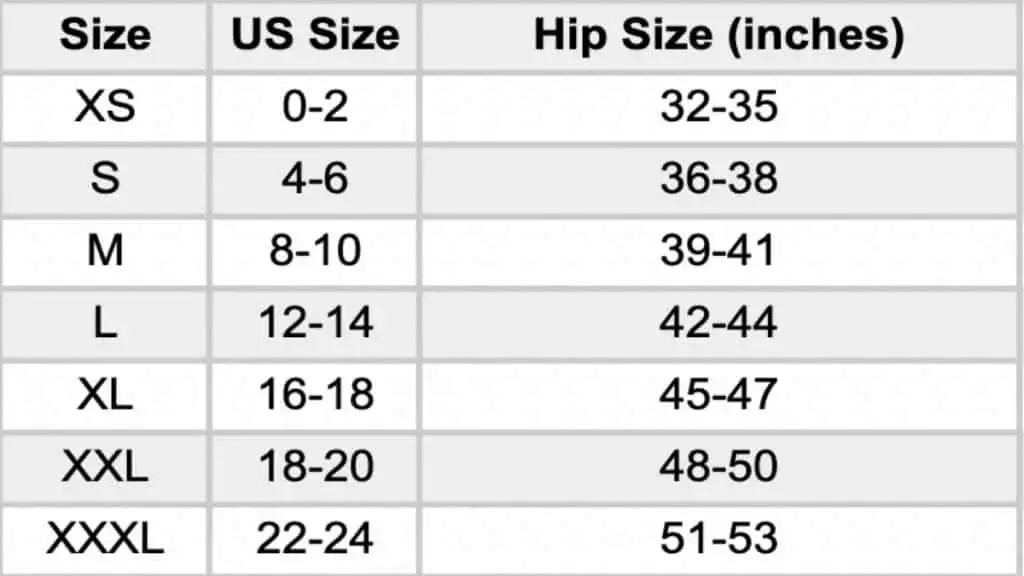
The specific clothing size for any given hip circumference measurement heavily depends on the brand of clothing, the type of garment, and the country in which the clothing is sold.
With this in mind, we analyzed the size charts of various clothing brands and created our own hip size chart for women that shows the clothing size (S, M, L), the corresponding US clothing size, and also the full hip measurement in inches.
Hip size chart for women (circumference)
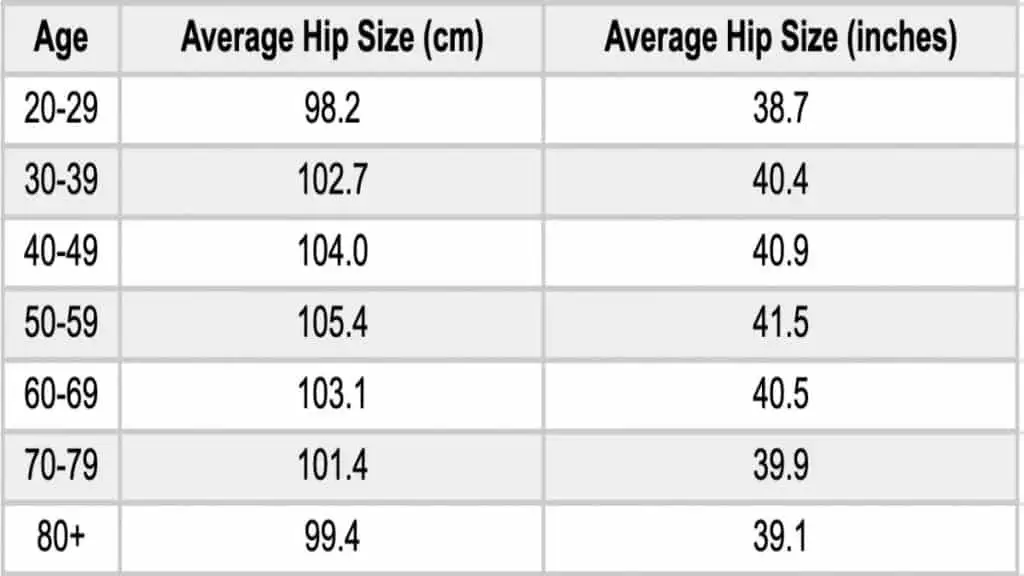
In the above chart, you’ll find the average hip measurements for women of various ages, which is useful for understanding how your body compares.
It’s interesting that women typically have larger hips than men by 1-2 inches in many cases, especially considering that data from the same sources shows that men had a larger biiliac breadth than women.
These differences indicate that women store more fat around their hips than men, which can actually be protective against cardiovascular disease. [3] Additionally, a large hip circumference can be an indicator that someone has a lot of fat-free mass.
As mentioned, female hip circumference peaks between the ages of 50-59 and then decreases gradually into old age, which may be due to inactivity and sarcopenia.
Although age is a strong predictor of the average hips size for women, your body composition and bone structure also affect your hip circumference measurement.
Male hip size chart (circumference)
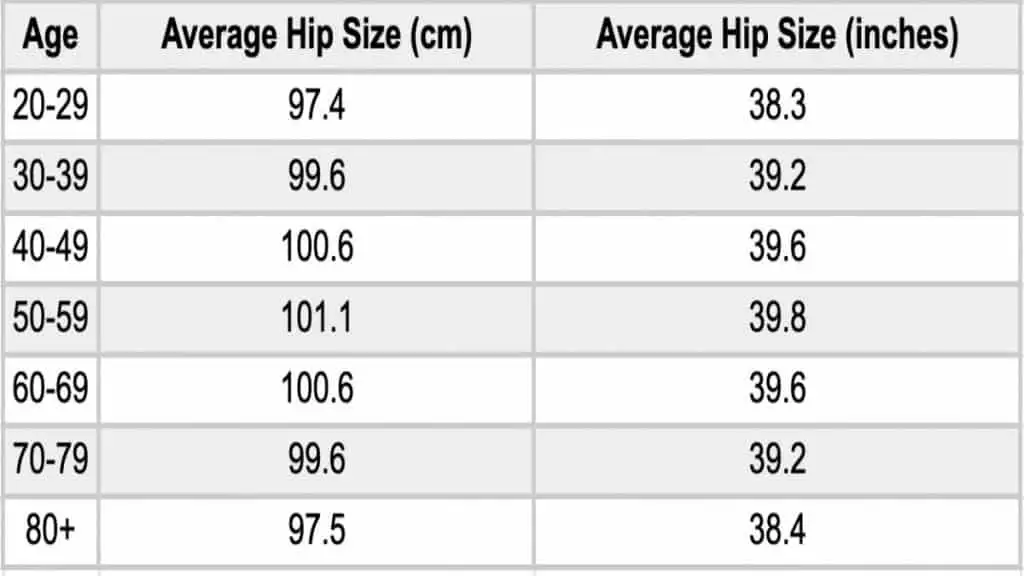
As you can see on the above hip measurement chart, male hip circumference is much more consistent than female hip circumference. Indeed, men aged 20-29 and men aged 80+ were found to have a virtually identical hip girth measurement.
As in the female measurement data, the largest average hip circumference in males was observed in men between the ages of 50-59. This is most likely due to middle-aged men having a higher body mass (and potentially more fat-free mass) than younger men.
When working with anthropometric data, you generally expect to see a decrease in circumference measurements—oftentimes significant decreases—as the participants get older. So it’s highly interesting to observe the general maintenance of hip circumference in men as they age.
This could well be because gluteal muscle mass—a strong predictor of hip size—is preserved by walking around, whereas other body parts (like the upper arms) aren’t used as much during everyday life (certainly not while walking like the glutes are) and thus require direct resistance training in order to maintain their girth.
Female hip width size chart
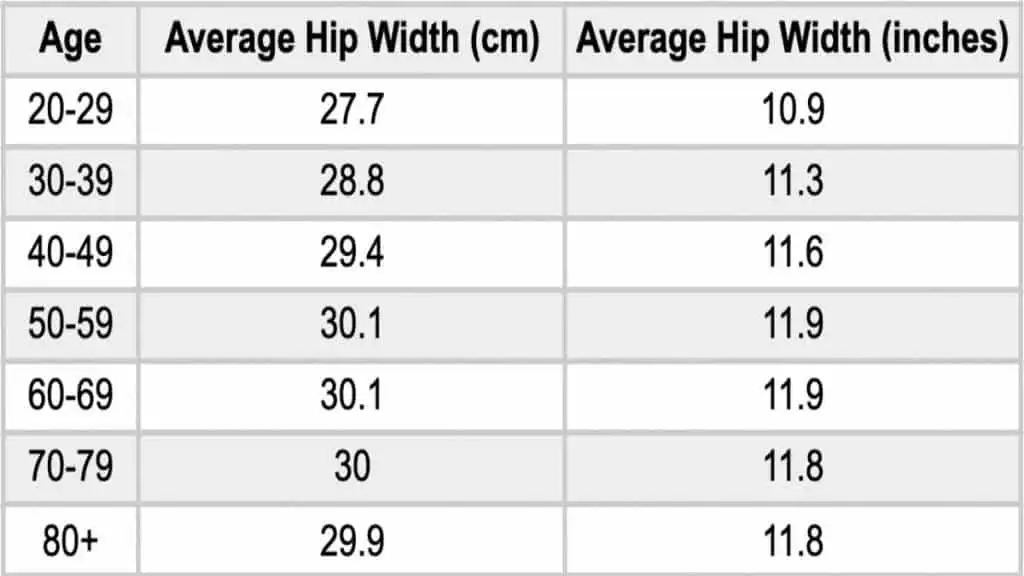
Based on the data displayed in the chart above, female hip width peaks between the ages of 50-69 (the same is true for males).
The reason for this is that older people have wider hips than younger people because the pelvic bones become wider with age.
Indeed, researchers from the University of North Carolina found that, on average, participants aged 80 had hips that were 2.2 cm wider than those aged 20. [4]
This data, which was published in the Journal of Orthopaedic Research, perfectly explains why hip width increases with age, although, based on the chart above, hip width does seem to level off at around age 50-60.
Male hip width chart
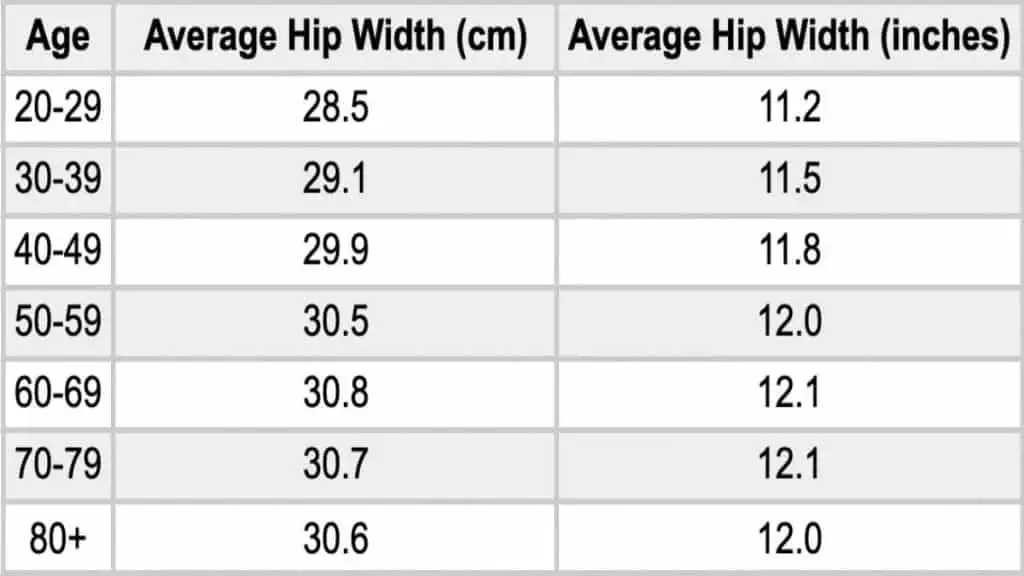
As with the women’s hip measurement data, male hip width increases with age and peaks between the ages of 60 and 79.
As mentioned, unlike many other bones in the body, research shows that the hips keep growing with age.
This explains why biiliac breadth (hip bone width) can increase with age, whereas hip circumference (which takes into account fat and muscle mass) tends to decrease with age.
How to measure your hips (circumference)
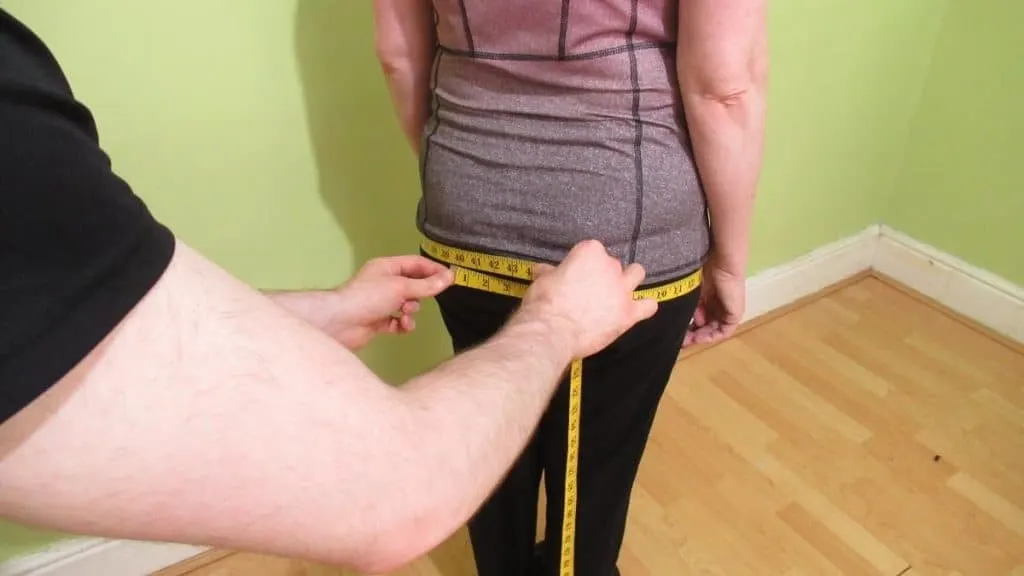
If you want to learn how to measure your hip circumference, then this is the guide for you.
It’s important to note that there’s no difference between measuring men’s hips and measuring women’s hips; you always measure around the fullest part of the buttocks when measuring a person’s hip circumference.
You can also measure your own hips in front of a mirror (you need to keep the tape measure straight).
For the best accuracy, however, it’s recommended to have your hips measured by someone else so that they can ensure that the tape measure remains parallel to the ground.
So with that said, here’s how to measure your hips with a tape measure.
- Stand up straight with your feet close together.
- Get someone to wrap a flexible tape measure around the fullest part of your buttocks (or do it yourself in front of the mirror).
- Ensure that the tape is straight around all parts of your hips.
- Pull the ends of the tape together so that the tape is wrapped securely around your hips. Don’t pull so tight that the tape digs into your skin.
- Observe where the two ends of the tape overlap; that’s your full hip measurement.
- Take 3 hip measurements in total so that you can verify your hip circumference measurement.
How to measure your hip width

Measuring your hip width (also known as biiliac breadth) is useful for determining your bone structure and frame size.
This kind of data is especially useful for scientists engaging in anthropometric study and bone development research, and it can also be used by exercise scientists to determine one’s gluteal muscular potential (large hips have more space for gluteal muscle mass).
To measure your hips width correctly, you’ll need a large bone anthropometer, which is the measuring device that you can see in the picture above. Avoid using a tape measure when measuring hip width because it will lead to inaccurate results.
- Get the subject to stand up straight with their feet close together.
- Locate the most lateral points on the outer edges of the iliac crest.
- Place the arms of the calipers on the outer edges of the iliac crest. Unlike circumference measurements, the skin should be compressed as we are measuring biiliac breadth, which is the distance between the widest parts of the hip bone.
- Note the measurement on the anthropometer and then remove the device.
- Consider taking second or third measurements to verify your accuracy.
Hip measurement FAQ
Learn everything there is to know about hip size in this helpful hip measurement FAQ.
What is hip size?
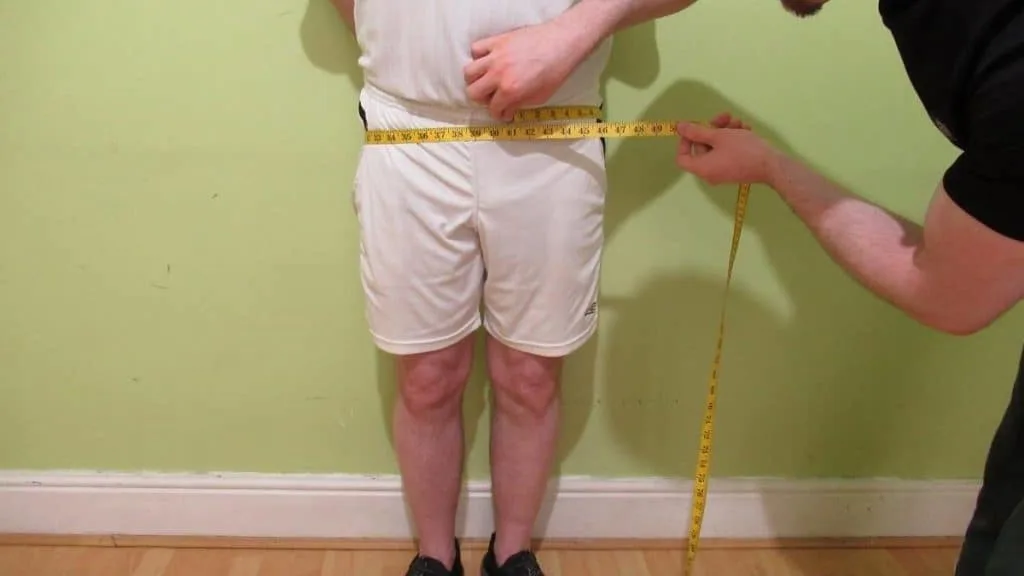
Hip size, also called hip girth, refers to the circumference of the human hips. Hip size is commonly measured with a flexible clothing tape and takes into account the width of your hip bones, the muscularity of your glutes, and the body fat around your hips.
Is there such a thing as the perfect hip size for a woman?

Is there such a thing as perfect hips for a woman? Data published in the International Journal of Obesity—which measured over 32,000 men and women in 19 different populations—found that the average hip measurements for men were between 37 inches and 41 inches and between 38 inches and 42.5 inches in women. [5]
So, based on this extensive research, you could say that the ideal hip size for women falls somewhere within this 5-inch range.
However, what’s more important is your waist-to-hip ratio. In general, research shows that women with a waist-to-hip ratio of between 0.65 and 0.75 (0.7 is often thought to be ideal) are rated most attractive by men. [6]
What is the ideal hip size for a 5’5″ woman?
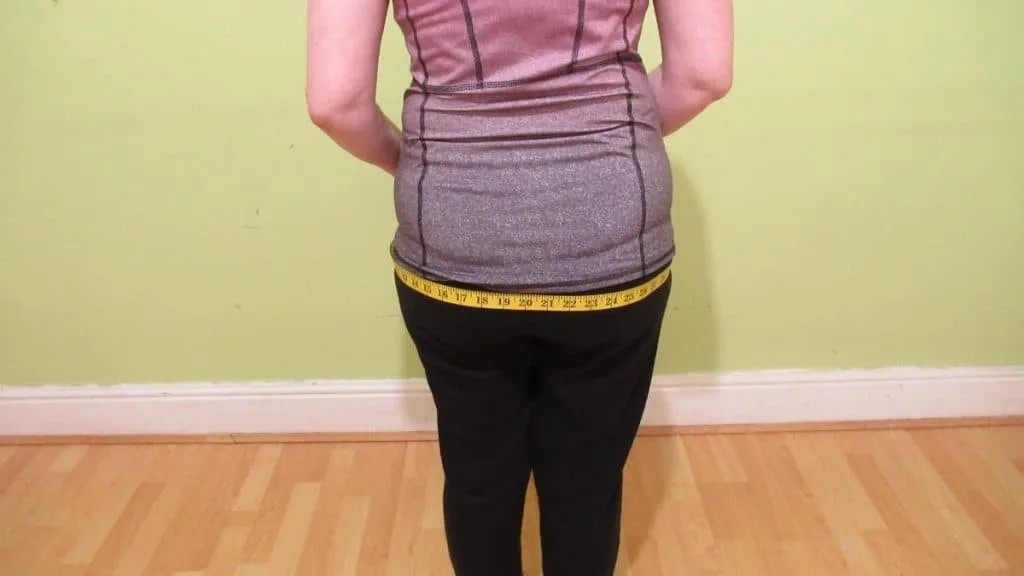
It depends on your waist, hip bone structure, ethnicity, and body fat level, but in general, the ideal hip size for a 5’5″ woman is between 37 and 42 inches.
As mentioned, it appears that your waist-to-hip ratio (WHR) is much more important than your hip size alone for determining attractiveness and also health, so make sure to factor in your other body measurements as well.
What is a healthy hip size?

What is a healthy hip measurement? There is no one healthy hip size—although you could say that the average measurements noted above are, for the most part, healthy.
However, the size of your hips means very little without your waist measurement.
Indeed, the size difference (or the ratio) between these two body parts is very important because women with a high WHR have an increased risk of cardiovascular disease, diabetes, and certain types of cancers.
Where should you measure your hips?
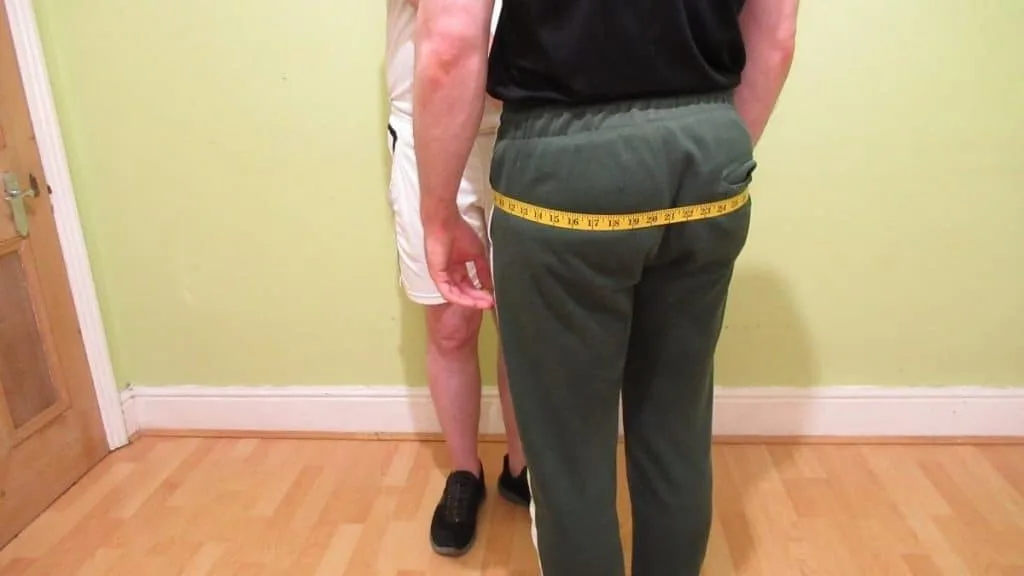
Where do you measure your hips? If you want to measure your hip circumference, make sure to measure around the fullest part of the buttocks. You may need to move the tape measure around to locate this area.
What is the difference between a hip width measurement and a hip circumference measurement?
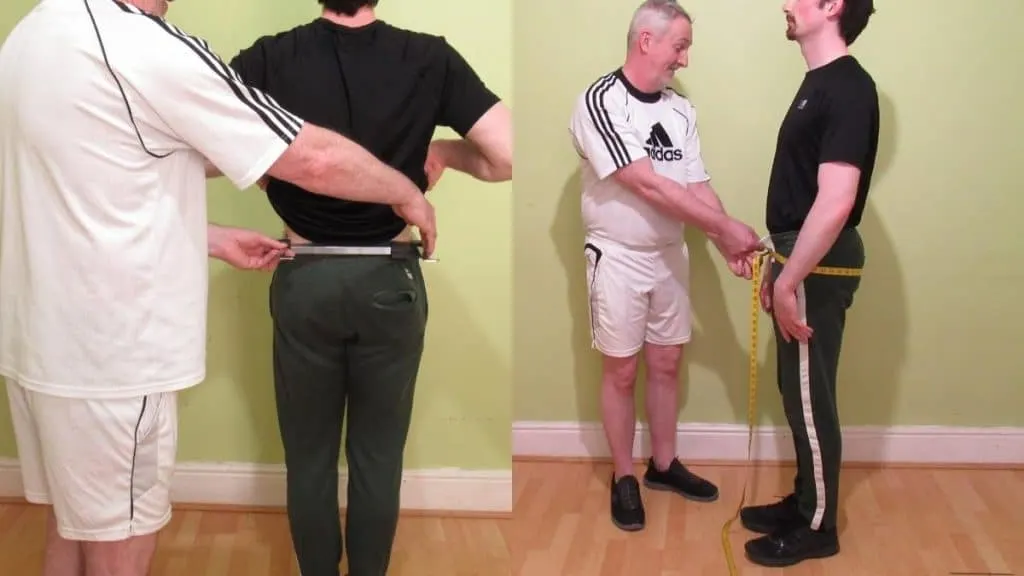
The main difference between hip circumference (also called hip girth) and hip width (also called biiliac breadth) is that hip circumference is measured around the fullest part of the buttocks, whereas hip width is measured between the most lateral parts on the outer edges of the iliac crest.
With this in mind, hip circumference factors in your bone mass, muscle mass, and fat tissue, whereas hip width only measures the width of your hip bone.
Hip circumference is useful for determining body composition, whereas hip width is useful for determining frame size and bone structure.
Finally, hip circumference tends to decrease after middle age, whereas hip width increases into old age.
Should you measure men’s hips and women’s hips differently?

No, you measure the hips of men and women in the exact same way, which is to say, around the fullest part of the hips/buttocks. You will find that, in general, women have a larger hip measurement than men.
How can you measure your hips without a tape measure?

Measuring your hips without a tape measure can lead to inaccurate results if you do it incorrectly. The best way to measure your hips without a tape measure is to wrap a flexible object (such as a piece of string) around your hips and then mark (using a pen) where the two ends overlap.
Then, you simply measure between the two points on the string using a ruler to get your hip girth.
Of course, your best bet by far for determining your hip size is to use a flexible tape measure.
What is the average hip size by height?
What is the average hip size by height? There is currently no good data that specifically looks at the average hip size by height. However, we know that, in general, taller people tend to have larger hips than shorter people due to having more bone mass.
Still, hip circumference tends to correlate better with weight and lean body mass than height. After all, it’s quite common to see tall people with slim hips. But you rarely see someone with a high body weight (be it fat or muscle mass) who has really small hips.
Conclusion: Should you aim for a normal hip measurement?

Now that you know the average hip size for women and the average male hip size, you probably have a good idea of how your body compares. So should you aim for a normal hip measurement?
As I’m fond of saying, health isn’t measured by the number on the tape measure, but nonetheless, having excessively large hips can indicate that you’re overweight or obese.
Yet, large hips—particularly when accompanied by a narrow waist—have also been shown to be protective against various chronic diseases and also increase your perceived attractiveness.
So while having an average hip circumference may well be beneficial, it’s not necessarily bad to have hips that are bigger than normal either.
References
- McDowell MA, Fryar CD, Ogden CL. Anthropometric reference data for children and adults: United States, 1988–1994. National Center for Health Statistics. Vital Health Stat 11(249). 2009
- Novak, J. M., Bruzek, J., Zamrazilova, H., Vankova, M., Hill, M., & Sedlak, P. (2020). The relationship between adolescent obesity and pelvis dimensions in adulthood: a retrospective longitudinal study. PeerJ, 8, e8951. https://doi.org/10.7717/peerj.8951
- Seidell, J. C., Pérusse, L., Després, J. P., & Bouchard, C. (2001). Waist and hip circumferences have independent and opposite effects on cardiovascular disease risk factors: the Quebec Family Study. The American Journal of Clinical Nutrition, 74(3), 315–321. https://doi.org/10.1093/ajcn/74.3.315
- Berger, A. A., May, R., Renner, J. B., Viradia, N., & Dahners, L. E. (2011). Surprising evidence of pelvic growth (widening) after skeletal maturity. Journal of Orthopaedic Research, 29(11), 1719–1723. https://doi.org/10.1002/jor.21469
- Molarius, A., Seidell, J., Sans, S., Tuomilehto, J., & Kuulasmaa, K. (1999). Waist and hip circumferences, and waist-hip ratio in 19 populations of the WHO MONICA Project. International Journal of Obesity, 23(2), 116–125. https://doi.org/10.1038/sj.ijo.0800772
- Kościński K. (2014). Assessment of waist-to-hip ratio attractiveness in women: an anthropometric analysis of digital silhouettes. Archives of sexual behavior, 43(5), 989–997. https://doi.org/10.1007/s10508-013-0166-1

